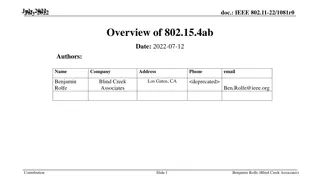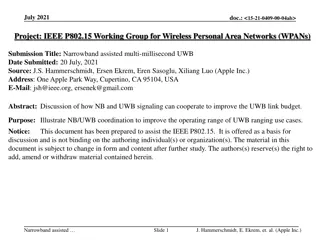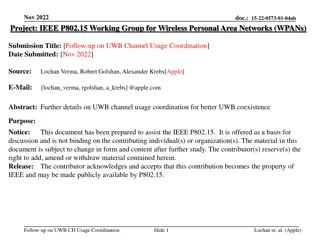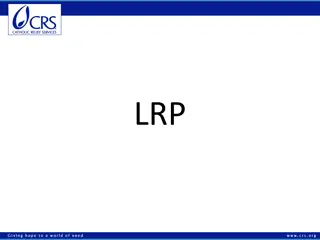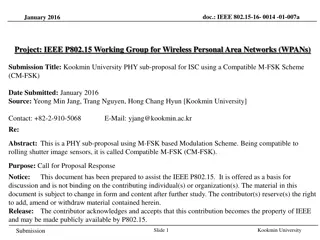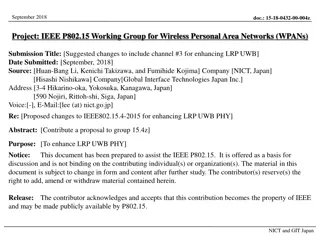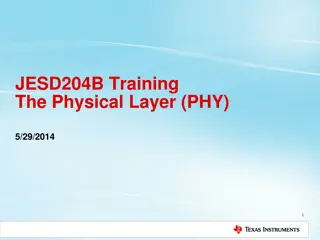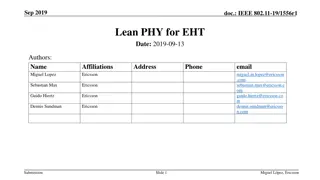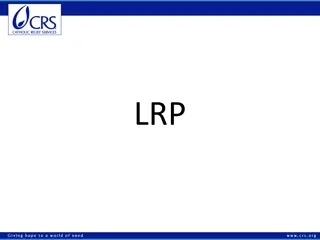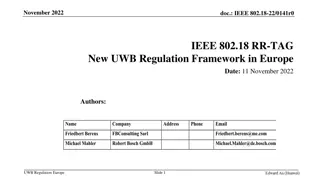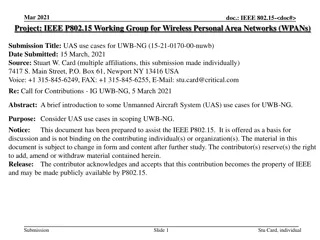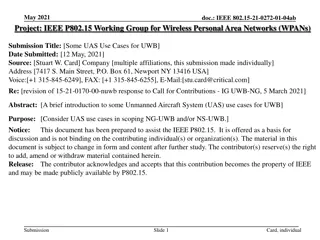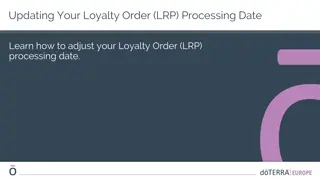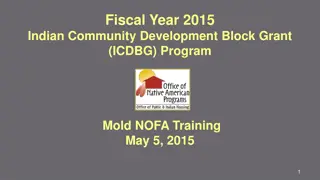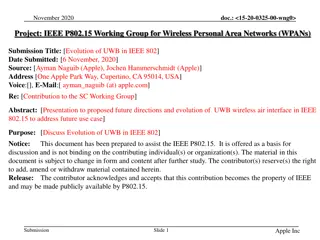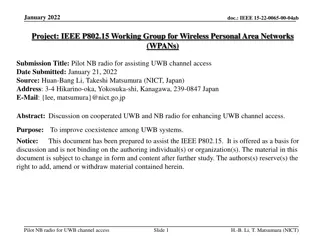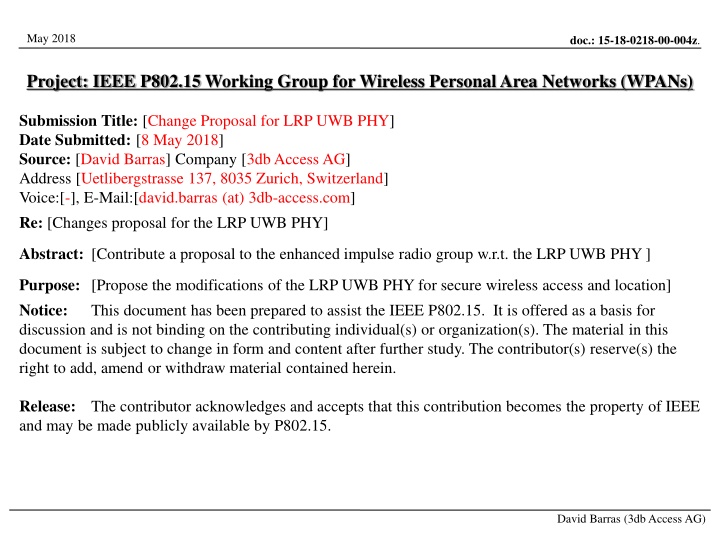
Proposal for Enhancing LRP UWB PHY for Secure Wireless Access
Contribute to enhancing the LRP UWB PHY for secure wireless access and location of Things. Discover the strong market demand and benefits of LRP UWB in terms of power consumption, size, complexity, and security. Explore how LRP UWB aligns with market needs with minor adjustments for optimal performance and security under a variety of applications.
Download Presentation

Please find below an Image/Link to download the presentation.
The content on the website is provided AS IS for your information and personal use only. It may not be sold, licensed, or shared on other websites without obtaining consent from the author. If you encounter any issues during the download, it is possible that the publisher has removed the file from their server.
You are allowed to download the files provided on this website for personal or commercial use, subject to the condition that they are used lawfully. All files are the property of their respective owners.
The content on the website is provided AS IS for your information and personal use only. It may not be sold, licensed, or shared on other websites without obtaining consent from the author.
E N D
Presentation Transcript
May 2018 doc.: 15-18-0218-00-004z. Project: IEEE P802.15 Working Group for Wireless Personal Area Networks (WPANs) Submission Title: [Change Proposal for LRP UWB PHY] Date Submitted: [8 May 2018] Source: [David Barras] Company [3db Access AG] Address [Uetlibergstrasse 137, 8035 Zurich, Switzerland] Voice:[-], E-Mail:[david.barras (at) 3db-access.com] Re: [Changes proposal for the LRP UWB PHY] Abstract: [Contribute a proposal to the enhanced impulse radio group w.r.t. the LRP UWB PHY ] Purpose: [Propose the modifications of the LRP UWB PHY for secure wireless access and location] Notice: This document has been prepared to assist the IEEE P802.15. It is offered as a basis for discussion and is not binding on the contributing individual(s) or organization(s). The material in this document is subject to change in form and content after further study. The contributor(s) reserve(s) the right to add, amend or withdraw material contained herein. Release: The contributor acknowledges and accepts that this contribution becomes the property of IEEE and may be made publicly available by P802.15. David Barras (3db Access AG)
May 2018 doc.: 15-18-0218-00-004z. ToC 1. Scope/Motivation 2. RTToF & Turnaround Time 3. LRP UWB PHY Modes David Barras (3db Access AG)
May 2018 doc.: 15-18-0218-00-004z. Scope - Why LRP UWB PHY ? LRP UWB PHY has been identified as the closest to enable Secure wireless access and location of Things A true secure wireless access system is only achievable by a 1 pulse-per-bit scheme, for which energy associated with information is constrained on the shortest period of time. LRP UWB PHY also offers ultra-low power by its simplicity of implementation and its ability of demodulation and decoding with zero latency (i.e. measurement is immediately available) David Barras (3db Access AG)
May 2018 doc.: 15-18-0218-00-004z. Scope - Why LRP UWB PHY ? Strong market demand across all verticals for: Low cost of ownership (minimum size and BOM) Ultra-low power consumption (coin cell battery, several years of battery life) Low complexity and easy set-up (tolerance to different propagation environments) Provably secure (scientifically analyzed and proven) David Barras (3db Access AG)
May 2018 doc.: 15-18-0218-00-004z. Scope - Why LRP UWB PHY ? LRP UWB perfectly fits the market demand with minor changes LRP UWB enable ultra-low power consumption (<<10 J per ranging): car/home/corporate/PC access, payment, location of things operated on small things such as keys, tags, wristwatches, pave the way for wake-up on UWB radio devices LRP UWB achieves optimally minimum silicon size (< 3 mm2) with minimum BOM LRP UWB achieves provable security under the strongest attacker model by means of classical challenge/response protocols David Barras (3db Access AG)
May 2018 doc.: 15-18-0218-00-004z. Scope - LRP UWB PHY Enhancements Enhance the LRP UWB PHY to enable a new class of devices that will be used for secure wireless access and location of things with by adding two main features: round-trip time-of-flight for C/R protocol robust timing for distance bounding protocols David Barras (3db Access AG)
May 2018 doc.: 15-18-0218-00-004z. Fixed Rx-to-Tx Turnaround Time (1/5) Purpose: enable a new class of devices capable of secure ranging with round-trip time-of-flight (RTToF) measurements RTToF in PHY crucial for implementing a classical challenge- response protocol; No timestamps exchanged, distance is measured in a secure way from the initiator only; LRP UWB PHY does not define Rx-to-Tx nor Rx-to-Tx turnaround times since LRP UWB PHY was not intended for RTToF (but rather for TDoA); Initiator Responder Nv ts tp Np tr Secure distance measurement = (tr-ts-tp)*c/2 David Barras (3db Access AG)
May 2018 doc.: 15-18-0218-00-004z. Fixed Rx-to-Tx Turnaround Time (2/5) PHY PIB attribute changes: add the attribute for round-trip time-of-flight that specifically use a fixed turnaround time A device supporting ranging measurement already has PHY PIB read-only attribute phyRanging (by default for LRP UWB PHY); A device able of answering in a fixed turnaround time will be defined by the new PHY PIB attribute in Table 11-2: Attribute phyRttof Type Boolean Range TRUE, FALSE TRUE if Round-Trip Time-of-Flight with fixed Rx-to-Tx turnaround time is supported; FALSE otherwise. Description For device supporting RTToF, the Rx-to-Tx turnaround time shall be defined with a fixed value (on the other hand, the Tx-to-Rx can re- use the definition in 10.2.1 with appropriate value in Table 11-1 ) David Barras (3db Access AG)
May 2018 doc.: 15-18-0218-00-004z. Fixed Rx-to-Tx Turnaround Time (4/5) A new PHY PIB attribute is proposed for devices supporting a fixed Rx-to-Tx turnaround time Update of Table 11-1 PHY PIB attributes: Attribute Description Value RX-to-TX or TX-to-RX turnaround time (in symbol periods), as defined in 10.2.1 and 10.2.2 For the SUN, TVWS, and LECIM FSK PHYs, the value is 1 ms expressed in symbol periods, rounded up to the next integer number of symbol periods using the ceiling() function.aFor the LECIM DSSS PHY, the value is 1 ms expressed in modulation symbol periods, rounded up to the next integer number of symbol periods using the ceiling() function. The value is 12 for all other PHYs. aTurnaroundTime RX-to-TX or TX-to-RX turnaround time (in pulse periods) For the LRP UWB PHY supporting Round-Trip Time-of-flight with fixed Rx-to-Tx turnaround time, the value is 16 pulses periods for PRR=1 MHz and 32 pulses periods for PRR=2 MHz, i.e. 16 us. The Tx-to-Rx turnaround is less or equal than 16 us. If RTToF is not supported the value 0 is used. aFixedTurnaroundTime David Barras (3db Access AG)
May 2018 doc.: 15-18-0218-00-004z. Fixed Rx-to-Tx Turnaround Time (5/5) A device requiring a RTToF ranging measurement with fixed turnaround time response is notifying it directly in the PHR This saves network traffic prior RTToF configuration Only devices with attribute phyRttof=TRUE will interpret dedicated bit in PHR for immediate response with fixed Rx-to-Tx turnaround times RTToF Notification : bit 17 in the PHY Header of LRP device: no longer Reserved for RTToF capable devices shall be set for RTToF measurements with fixed turnaround response David Barras (3db Access AG)
May 2018 New Modes Dual-frequency modes doc.: 15-18-0218-00-004z. Add [optional] PHY modes ( normal and extended ) that uses alternate OOK channels (similar to a 2-FSK) Advantages: Timing: this mode always transmits a pulse in either one of the two used frequency bands this avoid long series of pulse periods without energy (4f already implements some mechanisms) increasing energy in each pulse period is optimum for pulse/bit synchronization (a key parameter for secure ranging!) but this should not be done at the cost of higher power spectral density ! 1 0 1 1 0 OOK 2-FSK David Barras (3db Access AG)
May 2018 New Modes Dual-frequency modes doc.: 15-18-0218-00-004z. Advantages (cnt d): PSD: using two distinct frequency band allows halving the BW of a pulse for the same overall Tx BW and peak PSD reduce the constraint on the [full-band] peak power of the pulse (doubling the BW requires doubling the peak pulse RF voltage for keeping peak ESD constant) better fits deep-submicron technologies -70 2 Energy Spectral Density [dB(mWs/MHz)] @ Zo = 50 Ohm Dual-frequency OOK -10dB BW Dual-frequency OOK -75 1.8 -80 1.6 -85 1.4 -90 1.2 amplitude [V] -95 1 -100 0.8 -105 0.6 -110 0.4 -115 0.2 -120 0 5.6 5.8 6 6.2 6.4 6.6 6.8 7 7.2 7.4 0 1 2 3 4 5 6 7 8 9 10 Frequency [Hz] time [ns] 9 x 10 David Barras (3db Access AG)
May 2018 New Modes Dual-frequency modes doc.: 15-18-0218-00-004z. To keep the packet as short as possible for reducing on-air transmission times (but without being impacted by IPI), the dual-frequency mode is proposed with a PRR of 2 MHz. The dual-frequency modulation is proposed in two modes: dual-frequency mode with single pulse per bit, for secure ranging and efficient management of network of ranging devices and/or anchors; Extended dual-frequency with 4 pulses per bit encoding for improved [secure] ranging sensitivity and location of things; David Barras (3db Access AG)
May 2018 New Modes Mandatory/Optional Modes doc.: 15-18-0218-00-004z. Make the Extended and Long-Range PHY modes optional in UWB LRP PHY, keep only Base mode as mandatory mode Today s statements: All transmit modes are optional, but all modes shall be implemented in the receiver and operational concurrently Proposed change : Base mode shall be implemented in the receiver and the transmitter, other modes are optional. David Barras (3db Access AG)
May 2018 doc.: 15-18-0218-00-004z. New Modes Summary Table To add in section 17.1: In dual-frequency mode, LRP UWB PHY symbol consists of the presence of pulses at either one of the center frequencies defined in TBD, transmitted in 2 MHz PRF train. In extended dual-frequency mode, LRP UWB PHY symbol consists of the presence of pulses at either one of the center frequencies defined in [TBD], transmitted in 2 MHz PRF train and generated by convolution with octal generators (5,7,7,7). DataRate as used in MCPS-DATA primitives PRF (MHz) Mode Data Rate Modulation Implementation Long range mode 2.0 1 31.25 kb/s PPM optional Extended mode 1.0 2 250 kb/s OOK optional Base mode 1.0 3 1 Mb/s OOK mandatory Dual-frequency mode 2.0 4 2 Mb/s 2-FSK optional Extended dual- frequency mode 2.0 5 500 kb/s 2-FSK optional David Barras (3db Access AG)
May 2018 doc.: 15-18-0218-00-004z. Modes 4f PSD Mask Compliance Add in Section 19.7.1 For both dual-frequency and extended dual-frequency modes, the un- modulated instantaneous frequency response (fdev=0) as well as the modulated frequency response shall comply with the Transmit PSD mask defined in section 19.7.3. David Barras (3db Access AG)
May 2018 doc.: 15-18-0218-00-004z. Q & A David Barras (3db Access AG)


